"It felt like you were on a pirate ship,” says Alessandro Pietropaolo, describing what working at Bar Isabel was like in its early days. Back in 2013, the College Street tapas joint was open until 2 a.m., catering to a restaurant industry crowd that would show up to devour fried chicken, shoot bone luges and knock back beers. “Grant [van Gameren] would write a late-night menu by hand, arbitrarily deciding what he wanted to serve — it was an exciting time. We were like pirates with better clothes,” says Pietropaolo, one of the owners at Bar Isabel.
Toronto’s obsession with tapas, which Bar Isabel pushed into the mainstream, changed the way we eat. These days, snacking menus are ubiquitous, but a decade ago, small plates were a foreign concept. When it came to Spanish food, your choices were polished restaurants like Patria or Cava, which both offered a traditional meal cadence (appetizer, main, dessert). “We were more down-scale…grittier,” says Pietropaolo. “Dirty Barcelona by way of Toronto. With dust in the corners, and graffiti on the side of the building.”
Today, Bar Isabel looks much the same, with its lofi nautical interiors. Its kitchen still churns out made-for-sharing Spanish plates. But things have changed. “We’re more knife-and-forky and our wine list is better,” he says.
After nine years of slicing jamón, Bar Isabel has gone from Blackbeard bacchanal to curated cruise. “We influenced the broader culture of the city, and now we can continue as an established place. We’ve swapped our stilettos for sneakers,” says Pietropaolo, who has worked with the who’s who of Toronto F&B talent over the years. Brandon Olsen, Guy Rawlings, Owen Walker, Keenan McVey, Nate Young and Ryan Baddeley all have Bar Isabel on their CVs, and all went on to open some truly fantastic businesses.
Although Bar Isabel has incubated a ton of Toronto talent, it wasn’t always the best place when it came to work-life balance. For the majority of his tenure at Bar Isabel, Pietropaolo regularly weathered 70-hour workweeks. He had become a crepuscular creature, often heading home as the sun was rising. After years of helming the Bar Isabel ship, Pietropaolo has graduated from assistant general manager to co-owner. With this title change, Bar Isabel’s newest operating partner has worked to improve the restaurant’s work culture by implementing a 20 per cent net autograt, trying to keep staff to 40-hour weeks, and closing at a somewhat reasonable hour.
As a result of the pandemic, Pietropaolo, has streamlined the menu. After two tumultuous years, labour-intensive fan favourites, such as sweetbreads and croquettes, have been relegated to guest appearances (each requires a dedicated cook on the line, which isn’t always possible these days). The menu is currently a collection of Bar Isabel’s greatest hits. “Innovation is not something we are chasing anymore. We’re chasing legacy and you get that by stability,” he says. “I want to be a restaurant that’s going to be here for 50 years.”
According to Pietropaolo, Bar Isabel’s special sauce isn’t what comes out of the kitchen. “Don’t get me wrong, our food is good, and we have a high baseline for quality, but is it the best? I don’t think so.”
What sets his fiefdom apart is the dining experience. With his wild, jaw-length grey hair contrasted by a well-manicured beard — and a predilection for dropping recherché references — Pietropaolo seems more ringmaster-turned-professor than maître d’. “A lot of restaurants play checkers and we play chess,” he says. “Most restaurants have hosts, we have maître d’s. Someone from management is always directing service. That’s how we can get 220 covers out of a 60-seat room in six hours without anyone ever feeling rushed.”
According to Pietropaolo, it’s his staff that make Bar Isabel’s heart beat. “They know how to create an experience,” he says. “You don’t come here for a particular dish. It’s the vibe that makes it hard to get a table here.”
Bar Isabel's most iconic dishes
Octopus
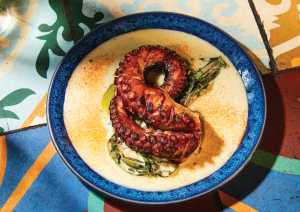
Carmen Cheung
“When we opened, this was the dish that really made a splash. Every magazine wanted a picture of the whole octopus. The foundations of the dish are simple, but god is in the details — it’s the execution that makes it taste like something you’d eat on holiday in Santorini. We get the octopi in whole, they’re then brined, steamed and grilled on a high heat, so that it’s finished with some nice char. It’s important to leave a little chew on it, or it’ll get stringy. Then, it’s served on top of a lemon-garlic-butter emulsion. The octopus is garnished with a few grilled dandelion greens, which a lot of people eat around, but without bitterness, life is too sweet.”
Jamón Ibérico de Bellota
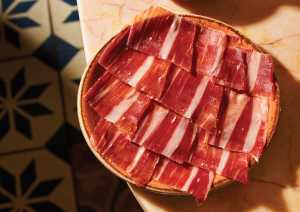
Carmen Cheung
“In Spain, if you’re eating straight ham, it’s Bellota. Serrano is just for sandwiches. It’s like comparing Luther Vandross to a screechy eight-year-old: There is no comparison. Serrano hogs are of no particular providence. Bellota pigs are these dainty, dark-haired creatures with a rich, unmistakably nutty flavour. Almost oily. These pigs transform the fat from the acorns they eat into oleic acid — it’s why they’re called walking olive trees. We get in whole legs of Bellota, bone-in, from Joselito Jamón. (Ferran Adrià named their ham best in the world.) I dream about one day offering Bellota sliced tableside, but I think my chef [Carol Thommen] would kill me.”
Mussels Escabeche “Isabel”
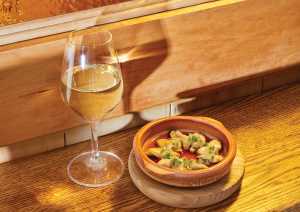
Carmen Cheung
“My friend Catalan Bob says that ‘In Toronto, opening a tin of fish is a convenience. In Spain, it’s a luxury.’ There was a lack of understanding around that when we opened. The mussels escabeche is a nod to traditional Spanish conservas, but unlike the real thing, we don’t cook ours in the tin. The mussels come from Salt Spring Island (they’re a large hybrid cultivar called Blue Gallo). We steam them, shuck them and then chuck them in the pickling brine that’s flavoured with paprika, wine, wine vinegar and a lot of bay leaf (an underrated herb, if you ask me). It’s a well-thought-out dish that uses excellent, high-quality ingredients — and the fact that it’s made with Canadian shellfish is a nice bonus. Although it’s high in prep work, you can get it out quickly during service.
Bone Marrow
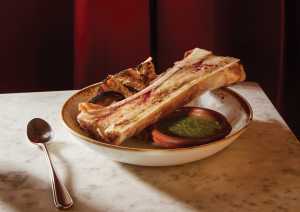
Carmen Cheung
“We don’t really do a lot to this dish. It’s a roasted canoe-cut veal bone served with grilled sourdough (made in house), persillade-style chimichurri and Maldon sea salt. We do make sure the wells are deep, so there’s a good portion of marrow per serving, and we purge the bones by soaking them in salt water to get that nice white marrow. This dish has been on the menu since we opened, and was a big late-night favourite when we used to cater to the industry crowd until 2 a.m. People still love bone luges — when you shoot Amontillado with the bone it picks up all that umami stuff. Calvados, mezcal and bourbon also make great shots, although we’ve been doing a number of low ABV options, too, lately.”
Basque Cake with Sherry Cream
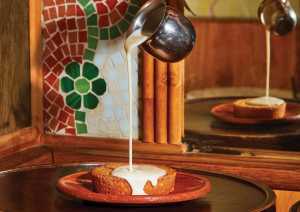
Carmen Cheung
“This has been on the menu since day one. It’s not traditional Basque cake, so it surprises Spanish people when they order it. Ours is a short pastry with pastry cream baked in the middle. There are no almonds, and unlike most Basque cakes which come by the slice, ours are individualized. It’s also served with flare in the form of a sherry cream sauce that gets poured over top. This dessert is so simple, but it just smacks. It hits. I think once somebody didn’t like it, and I just thought… you’re wrong. We have tried putting other desserts on the menu, but 90 per cent of our guests want this. So, why fix a problem that doesn’t exist?”
Bar Isabel, 797 College St.; barisabel.com
